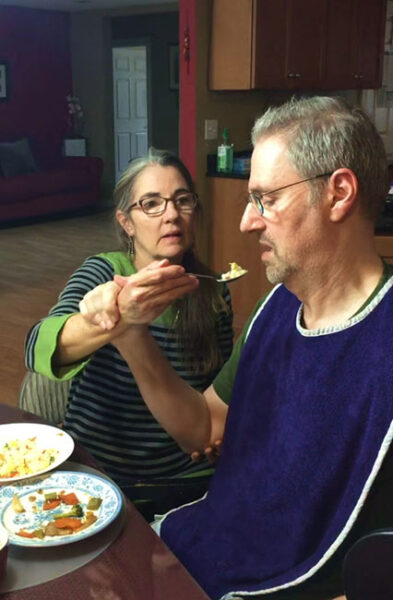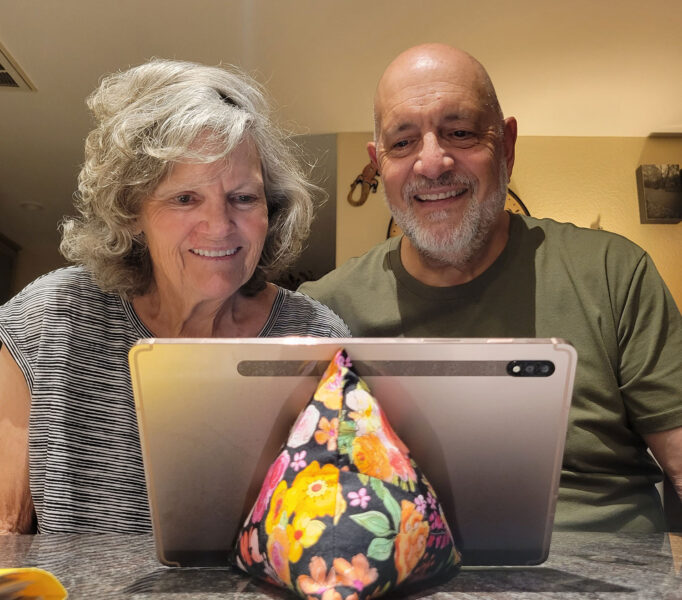by Berenice Freedome
Allyson Schrier was tired from rushing around east Seattle on family errands by the time she arrived at her husband’s room for their second visit that day. There her sweetie was, sitting up in his chair, stuck in front of mindless TV. Again. Now it was blasting the Tarantino movie Kill Bill.
Most 51-year-old men wouldn’t think twice about watching a sexy female assassin hack people up with a sword. But Evan was in year five of a Frontotemporal Dementia diagnosis and the progressive degeneration of his brain's frontal and temporal lobes meant his strange behaviours and language disorders had also devolved his ability to tell fact from fiction.

Were these violent murders really happening in front of him? Would he and Allyson be next?
It took a while for Allyson to calm Evan down, and even longer to calm herself down from feeling anger at the well-meaning staff of the assisted-living care home who’d probably turned on some innocuous show to entertain him and left the TV playing longer than they should have.
In the common room, they found another TV on. This one was playing a black and white movie from the 1950s. Allyson watched one agitated resident glance to and from the screen, visibly straining to process the dark, cluttered shots of fast-moving, fast-talking actors. It was a classic film and the staff’s intention in playing it was to evoke a soothing bit of reminiscence for the memory care residents. So why was everyone else asleep?
Dementia and other cognitive changes will often slow the brain’s processing speeds. It might take 20 seconds for a single phrase or image to register. Once a person’s brain can no longer follow the plot, dialogue, and pace of a regular TV show or movie, it tends to either panic or power down. People who sleep all day are often awake and wandering around during the night, risking falls and disturbing other residents.
Some people in this situation might have fired their care home. Allyson got fired up.
After all, this wasn’t an uncommon experience: she’d seen it repeated in every residence she’d been to. “The majority of caregivers rely on TV to occupy residents. They aren’t aware of the problems this creates, they’re trying to do their best,” she said, “So why isn’t there a dementia-friendly channel they can turn on that’s positive, soothing, and designed to be appropriate for people’s changing brains?”

After all, Dementia is not a problem that’s new, or that’s going away. Worldwide, more than 55 million people are living with dementia. With nearly 10 million new cases every year, the number of people affected is set to rise to 139 million by 2050.
Allyson had seen these shocking statistics playing out in her own family. Her stepfather was diagnosed with vascular dementia, and her stepmother with Alzheimer’s disease in their 80s. Evan was just 47 at the time of his diagnosis, when their children were 12 and 15.
Allyson was determined to do something. It was a pervasive problem: well-intentioned caregivers consistently chose inappropriate TV options simply because appropriate programs did not exist. YouTube was no better, with bursts of startling, extra-loud ads and an algorithm that keeps eyes riveted by queuing up sensational (and often inappropriate) content to play next.
Allyson read all the scientific literature she could find on the topic of why programming designed for healthy brains doesn’t work for people facing mid- to late-stage cognitive challenges — including one study that showed how intentionally built, gently-paced, unclutttered media could be an effective alternative to regular TV.
She started to explore what ‘better’ viewing options might look like. Using the Apple Memories feature in the Photos app on her phone, she generated videos for Evan of family ski trips, beloved pets, their two teenage boys’ active lives, their wedding celebration.
“Watching these Memories gave us moments of joy and connection,” she said. Despite Evan’s slackened facial expression, she could see glimmers of his passions and his personality in his eyes as they watched.
“I wanted to play him more videos about the things he loved, and the things he loved to do as a healthy person — skiing, mountain biking, walking the dog, going to vineyards. That’s who he still was inside.” But Allyson did not have that kind of content on her phone.
How could she make these kinds of videos, and how could she make them available to other caregivers?
Through friends, Allyson connected with Frank Lee, who had been Apple Memories’ lead designer. He had just left Apple and was now able to work on other projects.
Hearing Allyson’s story, Frank was deeply moved. “I never anticipated that use case for Memories,” he said. He was thrilled to know the app was helping people facing a Dementia diagnosis connect with their loved ones, and was confident they could build a solution to support more people facing cognitive change.
Allyson wanted to name the streaming service Zinnia, after the hardy annual that can endure the harshest conditions and still produce cheery colourful flowers that represent friendship, endurance, remembrance and lasting affection.
Since I’m a videographer, visual artist, and writer, they brought me on to build the content library, and we added Bill Uniowski to turn Zinnia into a viable business without diminishing the care experience by adding advertisements.
Zinniatv.com is now a streaming service that’s available as an app for Roku, Apple TV, iOS, Android, Android TV, Amazon Fire TV, and Samsung Tizen.

Caregivers regularly report watching Zinnia on their own when they need a moment of calm. We also offer education and self-care videos, as the stress of caregiving far too often causes the caregiver to die before the person they are caring for.
Allyson’s husband Evan never got to watch the dementia-friendly streaming service he’d inspired. But his legacy as a father, friend, coder, and beloved husband now also includes being the inspiration for a company that is determined to help people give, and receive, better care.
You can help Zinnia by spreading the word on social media, signing up for a free Zinnia trial, or gifting a membership to a caregiver you know at zinniatv.com/.
https://www.instagram.com/zinnia_tv?igsh=M201ZjNwNzVkb2s1
https://www.linkedin.com/company/zinnia-technologies-inc
https://www.facebook.com/profile.php?id=61553111532040
HOW YOU CAN CREATE IMPACT:
 5 MINUTES: Tell people about Zinnia.
5 MINUTES: Tell people about Zinnia.
 5 DOLLARS: Gift a zinniatv.com subscription to a caregiver you know.
5 DOLLARS: Gift a zinniatv.com subscription to a caregiver you know.
 5 DAYS: Volunteer at a local Memory Care residence to watch Zinnia TV with residents and encourage conversation, then encourage the facility to sign up for a subscription.
5 DAYS: Volunteer at a local Memory Care residence to watch Zinnia TV with residents and encourage conversation, then encourage the facility to sign up for a subscription.
Get in touch with the Zinnia team to help Zinnia with financial investment, creative or marketing services, or even a simple social media boost.